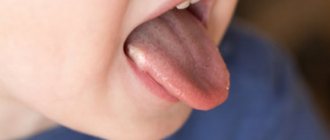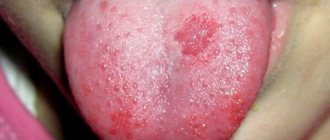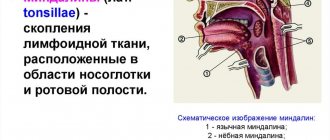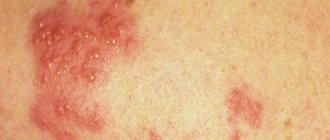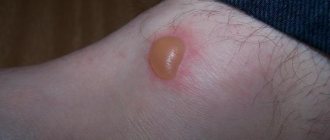Causes of childhood stomatitis
There are 6 main factors that can provoke the occurrence of stomatitis in the mouth in infants:
- infections;
- mechanical damage;
- physical agents;
- chemical burns;
- allergic reactions;
- poor oral hygiene.
All conditions that cause immunodeficiency in a child predispose to the occurrence of such a pathology: chronic diseases of internal organs, vitamin deficiencies, the presence of foci of chronic infection in the body, stress, climate change. Dr. Komarovsky notes an increase in the incidence of stomatitis in children who often suffer from ARVI.
In the photo: stomatitis on the tongue
Infectious forms of the disease are the most widespread. Most often, herpetic stomatitis occurs. Also, lesions of the mucous membranes of the oral cavity can appear against the background of various infections: smallpox, measles, rubella, entero- and adenoviruses. Banal staphylococci and streptococci, which normally live in small quantities in the mouth of every baby, also play a huge role in the development of the inflammatory process. Their effect increases only when the child’s immunological status decreases.
Quite often, after taking antibiotics (especially if the course of treatment is long), infants develop a fungal infection of the oral mucosa - candidiasis or thrush, which can also trigger the development of stomatitis.
Children, especially young children, learn about the world around them through taste. Therefore, babies constantly put into their mouths all the objects that are at their disposal. Thus, mechanical trauma to the mucous membranes simply cannot be avoided. And take into account the fact that objects are not always clean, inflammation forms very quickly. A child can independently injure the mucous membrane by biting it with his teeth. This is observed very often in dreams with neuroses.
When teething, gums are sometimes injured, which, coupled with the baby’s reduced immunity during this period, leads to a strong inflammatory response.
Of the physical agents, the most common cause of stomatitis is exposure to hot food. In this case, microburns occur on the mucous membranes, at the site of which inflammatory foci are formed.
Chemical burns occur due to accidental exposure of the oral mucosa to potent substances. In everyday life, this could be vinegar, high-concentration hydrogen peroxide, alcohol or eau de toilette, perfume, various paint solvents or liquid cleaning products.
Anything can act as an allergic component in the development of stomatitis. For example, harmless candy, toothpaste, chewing gum, various drinks, medications and food. Often, allergic stomatitis occurs in infants during the period of introducing the first complementary foods.
Severity and incidence in children
Based on the severity of symptoms, any type of stomatitis is classified into the following forms:
- Easy. There are no pronounced symptoms, intoxication of the body is practically excluded.
- Medium-heavy. There are numerous rashes in the mouth, the damage is serious. The child's condition is rapidly deteriorating.
- Heavy. It is characterized by severe intoxication, increased temperature, and multiple rashes in the oral cavity.
Dental statistics claim that there is a dependence of the type of stomatitis on the age of children. Infants and children from one to two years of age are more often affected by candidiasis and herpetic stomatitis. The candidiasis form is very insidious; a child can get sick with it several times a year. In children 2-6 years old, an allergic or aphthous form of the disease is more common.
The bacterial form equally often affects preschoolers and schoolchildren. Its causes are trauma to the oral cavity, poor personal hygiene, which is possible at any age.
Traditional recipes can complement therapy if the doctor deems it necessary. When a mother intends to use folk remedies, she should consult a doctor.
Medications
The type and dosage of the drug is prescribed by the doctor. The mother should strictly follow the instructions for use and treat the child exactly as much as the doctor said. The baby’s well-being can quickly improve, but early cessation of therapy risks the disease becoming chronic. Depending on the type of stomatitis, children are prescribed the following medications:
- Wound healing (Rotokan, Iodinol). Used to lubricate the mouth of children over 5 years old.
- Immunomodulators in the form of suppositories, gels (Viferon, Imudon, Cholisal).
- Painkillers and antipyretics. Kamistad and Dentinox gels numb and cool. Nurofen, Efferalgan relieve fever. The temperature for stomatitis should be brought down with medication only when it reaches 38 degrees.
- Antiseptics (Furacilin, Chlorhexidine). They are used for rinsing the mouth of children who have already mastered this skill and do not swallow liquid.
- Ointments with an antiviral effect (Viferon, Gerpevir).
- Shostakovsky's balm. Used for rapid restoration of mucous membranes.
- Antifungal. For candidiasis, Clotrimazole and Pimafucin are indicated.
- Antibacterial. Orasept and Tantum Verde are effective in treating bacterial diseases.
It is impossible to treat a child under 2 years of age with Fukortsin and brilliant green. This leads to worsening allergies and complicates the course of the disease.
Folk remedies
One of the common folk remedies for stomatitis is lubricating the affected areas with a soda solution. It can even be used to treat newborns and infants up to one year old, when most medicinal forms are prohibited.
To prepare the product, dilute a teaspoon of baking soda in a glass of water. It is better to treat the child’s oral cavity with cotton swabs, dipping them into liquid and lubricating problem areas.
Other effective folk methods include rinsing your mouth with freshly squeezed carrot juice, saline solution, propolis extract (8 drops per glass of water). Procedures can be performed up to 4 times a day.
Symptoms and signs
How to recognize stomatitis in children? Despite the abundance of causes that cause this disease, all forms of stomatitis have common clinical symptoms:
- The first signs of such a pathology are slight redness on the mucous membranes, which can be localized both on the gums and on the palate, on the tongue or on the lip.
- Gradually, the redness gives way to swelling, round or oval ulcers appear, covered with a whitish or gray coating on top and surrounded by a red cushion. These ulcers are very painful and prevent the child from leading a normal life, eating or sleeping.
- As the inflammatory process becomes more severe, small ulcers merge into one large one.
- Local signs of stomatitis are accompanied by general symptoms: the child’s temperature rises, weakness, and lack of appetite appear.
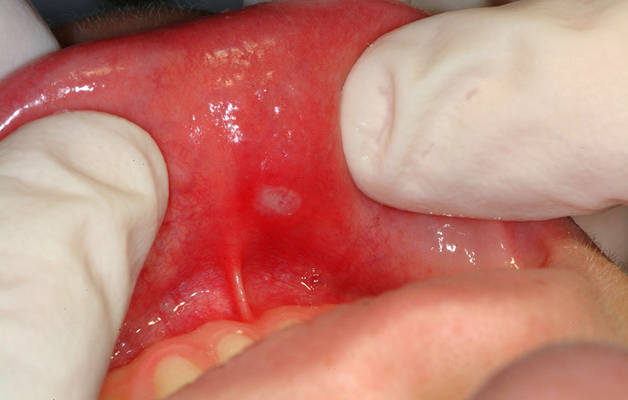
In the photo: stomatitis on a child’s lip
One of the features of the course of the disease is the appearance of vomiting with stomatitis. It is caused by increased work of the salivary glands and increased excitability of the baby’s nervous system due to severe pain.
Stomatitis on the tongue of a child - causes and treatment methods
Article verified by Dr.
Hello, dear readers. Many of you are parents and know well how often stomatitis can appear on a child’s tongue. Children are always grabbing at everything, putting their hands and various objects into their mouths. And then we have to treat them, fight worms and other things. But today I want to talk specifically about stomatitis.
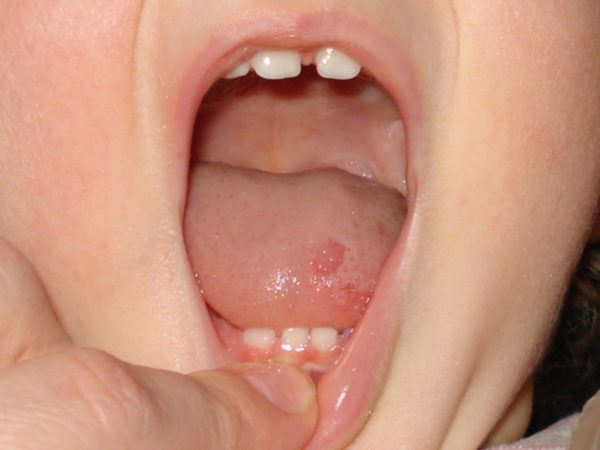
Stomatitis on the tongue of a child - causes and treatment methods
Types of childhood stomatitis and their main manifestations
The classification of childhood stomatitis is based both on the cause of the disease and on some distinctive features in the clinical course of such pathology. We will tell you how to determine this or that type of disease in our article later.
Catarrhal stomatitis
It is the mildest and most common form of the disease. In this case, multiple inflammatory foci appear on the mucous membrane of the gums, cheeks or lips, covered with a whitish coating, but without the formation of aphthae or ulcers. In this case, the child will complain of pain in the mouth when eating, drinking or talking, increased salivation, bad breath, and general weakness.
With catarrhal stomatitis, the mucous membrane is very susceptible to injury and bleeding, even during normal activities: brushing teeth, eating. When inflammatory foci are localized only on the gums, the clinical picture of stomatitis will resemble gingivitis.
Ulcerative stomatitis
The ulcerative form is a consequence of untreated catarrhal stomatitis. In this case, against the background of edematous foci of redness, multiple ulcerations are formed, which gradually increase in size, spread deep into the tissue of the mucous membranes or merge with each other.
The child complains of severe pain in the oral cavity, which intensifies when trying to brush his teeth or eat, and the smell of his breath becomes putrid. General health worsens: body temperature rises, weakness and body aches occur.
Young children are capricious, refuse to eat, and have trouble sleeping.
Gangrenous stomatitis
The gangrenous form of the disease is a continuation of catarrhal and ulcerative forms. A characteristic sign of this pathology is the spread of the inflammatory process deep into the tissues of the jaw with the development of extensive necrosis, which can involve the bones and spread to other anatomical areas.
The condition of a child with gangrenous stomatitis is extremely serious. There may be disturbances of consciousness, severe weakness, and the smell of rotting meat from the mouth. Regional lymph nodes are enlarged and painful on palpation.
Candidiasis (fungal or milk) stomatitis
Candidal stomatitis is characterized by specific symptoms. At the onset of the disease, children have dry mouth. Subsequently, a burning sensation and an unpleasant aftertaste appear. A white coating in the form of small dots is deposited on the mucous membrane. As the process progresses, the points merge into a large lesion that resembles a curdled mass. Such plaque is difficult to remove, exposing the inflamed surface of the mucous membrane.
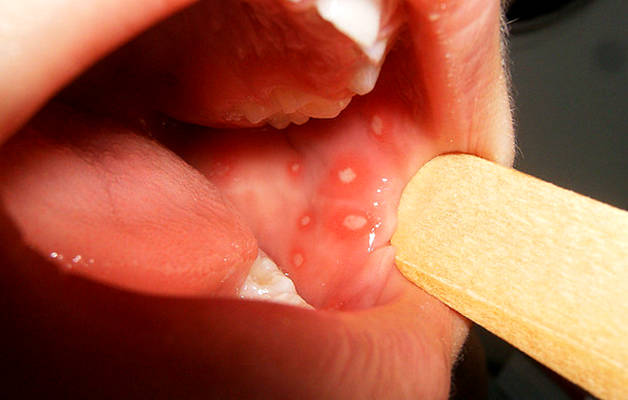
In the photo: candidal form of childhood stomatitis
Fungal stomatitis often occurs without fever, and the general condition is little affected.
Infectious stomatitis
The phenomenon of stomatitis can also be observed in some infectious diseases. With scarlet fever, the typical picture on the mucous membranes of the mouth will be supplemented by specific manifestations of the disease: a pinpoint rash on the skin and a “crimson tongue” - the surface of the tongue is bright red, shiny with hypertrophied papillae.
With diphtheria, damage to the gums will be combined with the detection of dense grayish films on the tonsils or in the throat. In this case, a paroxysmal cough with episodes of suffocation will be noted.
Allergic stomatitis
The allergic form of stomatitis most often affects children over 4 years of age. It is characterized by a clear connection with the action of the allergen, a rapid increase in symptoms and their rapid extinction with adequate treatment. The clinical picture in this case is similar to the ulcerative version of the disease - ulcers or aphthae form on the mucous membranes, covered with a whitish coating and surrounded by a focus of redness. Quite often, this pathology occurs in the form of chronic stomatitis with periodic episodes of exacerbation.
Traumatic stomatitis
In cases of mechanical trauma, a significant focus of infiltration appears on the mucous membrane, which ulcerates as the inflammation progresses. When burned by hot drinks, a bubble often appears, after opening which a fairly deep ulcer is exposed. A distinctive feature of the traumatic form of the disease is a clear connection with trauma or thermal burn of the oral mucosa and the formation of a single lesion.
In case of severe inflammation, local symptoms may be accompanied by general symptoms: fever, malaise, headache.
Herpetic stomatitis
In herpetic stomatitis, the main morphological element is small blisters located against the background of a hyperemic mucous membrane. They quickly open and erosions form, which are covered with fibrous plaque. The lesions can be localized separately or merge into a single affected area.
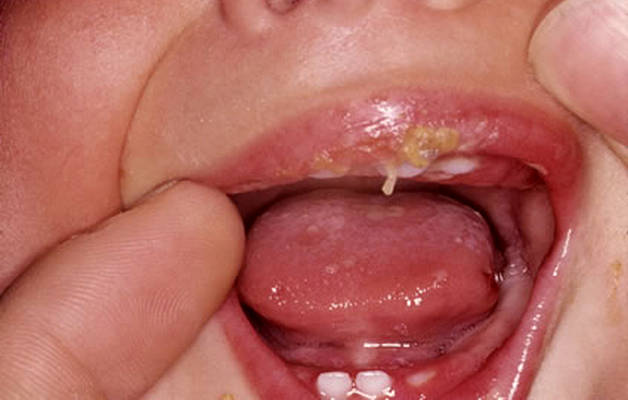
In the photo: herpetic stomatitis on a child’s lip
Erosion is extremely painful, the child refuses to eat, is capricious, sleep is disturbed, and in severe cases there is a significant increase in body temperature. In this case, typical herpetic lesions can be found not only in the oral cavity, but also on the face or other parts of the body.
Bacterial (purulent) stomatitis
Most often, bacterial stomatitis appears due to constant improper oral care or microbial sore throat. The clinical picture is typical for stomatitis: initially foci of inflammation appear, which then transform into deep ulcers covered with abundant purulent plaque.
At the same time, purulent deposits on the tonsils are detected, the child’s general well-being suffers, body temperature often rises significantly, and the cervical, submandibular and clavicular groups of lymph nodes enlarge.
Vesicular stomatitis
Vesicular stomatitis is an infectious disease. Its causative agent is vesiculovirus, a virus transmitted from sick animals to people. The incubation period of this disease is 5-6 days, during which children may complain of fatigue, weakness, and slight chills. Subsequently, small painful blisters with whitish contents appear on the mucous membranes of the oral cavity. Similar elements appear in the area of the feet and hands.
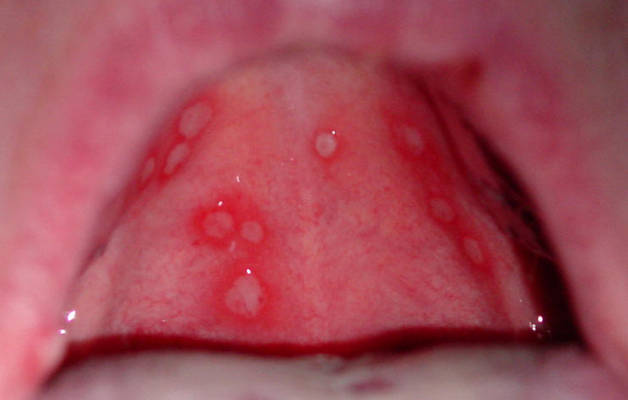
In the photo: vesicular stomatitis in an infant
The general symptoms are very similar to a banal acute respiratory infection: the body temperature rises, there may be signs of rhinitis and conjunctivitis. If the intestines are damaged, there may be dyspeptic symptoms: diarrhea or constipation.
Nutritional Features
Due to the fact that painful ulcers appear in the mouth with stomatitis, any meal gives the baby discomfort. Therefore, the diet during the period before recovery should have a number of features.
- All food taken should be warm and at a temperature as close as possible to body temperature. This will prevent unnecessary irritation and will not cause acute pain.
- Since chewing is quite painful, portions should be reduced by about a third, but the frequency of meals should be increased.
- When feeding your baby, you should give preference to dishes with a soft consistency, and it is better to postpone dense and dry foods until complete recovery.
- It is worth giving preference to products with a neutral taste. These are potatoes, bananas, pears, pumpkin.
- Until recovery, spicy, salty and sour foods are completely excluded from the child’s diet.
- To make eating less painful, you can purchase thick straws for cocktails and crush all food so that it can be drunk.
- The emphasis is on healthy foods rich in microelements and vitamins. For example, buckwheat, oatmeal, and rice can be recommended for cereals. It is preferable to give your baby cauliflower and broccoli as vegetables.
How to treat stomatitis on the tongue
Drug treatment
Treatment is carried out comprehensively with the selection of different groups of medications. All appointments are made only by a specialist. Self-medication of the disease is prohibited.
IMPORTANT: It is strictly forbidden to use medications that are intended for adults.
Before visiting a doctor, parents should carry out the following manipulations:
- Soak a cotton swab in hydrogen peroxide and gently use it to remove plaque from your tongue.
- You can give your child a pain reliever.
The doctor prescribes a complex of drugs, which includes:
- Painkillers. With stomatitis, the painful sensations are very pronounced, so gels and sprays are indicated to help reduce the pain threshold. The most effective are:
- Hexoral;
- Kamistad.
Dentinox;
If a gel is prescribed, it is applied to the painful areas using a cotton swab.
- Furacilin;
- Lugol. It is allowed to be used by children from the age of five;
- Clotrimazole;
- Diflucan;
- Ingafitol;
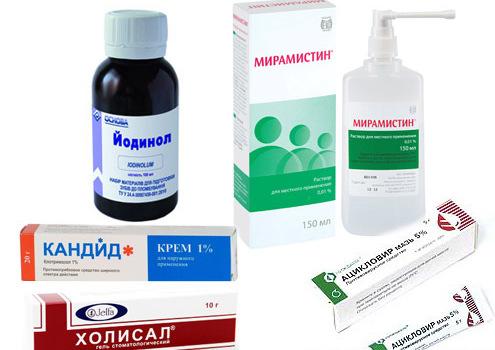
Medicines for stomatitis
Traditional methods of treatment
They are recommended for use in the early stages of the disease. A good result can be achieved if you combine traditional medicine recipes and the use of medications. The following recipes have worked well:
- Dilute a tablespoon of table salt in a glass of hot water and rinse 5-7 times a day.
- Dilute 5-10 drops of propolis in a glass of warm boiled water. Rinse your mouth 5-7 times a day until complete recovery.
- Finely chop aloe or kalanchoe leaves. Pour the juice with 5 tablespoons of water and stir. Apply to the sores, moistening a cotton swab with the composition in advance.
- Chop a few cloves of garlic very finely and pour them with 3 tablespoons of olive or sea buckthorn oil. Moisten a cotton swab or swab in the composition and apply to the wounds. You can simply hold this mixture in your mouth for 2-3 minutes without swallowing it.
IMPORTANT: The child may experience pain. In this case, this recipe is not recommended.
Having discovered stomatitis on the tongue in children, parents should not self-medicate . It is necessary to contact a dentist so that he can establish the correct diagnosis and prescribe adequate treatment. If there are few ulcers and they do not cause concern to the child, you can use traditional medicine recipes, which are not only very effective, but also safe for the baby’s body.
Is stomatitis contagious?
Infectious variants of the disease are quite easily transmitted from sick children to healthy ones. Most often, the infection spreads through airborne droplets from saliva during normal talking, coughing or sneezing.
The herpes virus can pass from an infected mother to the child during childbirth or during breastfeeding in the event of an exacerbation of herpetic inflammation.
We must remember that some forms of infectious stomatitis may well be transmitted through shared objects. This is especially true for cutlery, toys and personal care products. Therefore, if a child gets stomatitis, it is necessary to take measures aimed at preventing the possibility of its transmission to healthy children.
- If there is another child in the family, then it is worth protecting him from communication with the sick baby for at least a few days.
- It is imperative to provide the patient with individual household items that can be processed separately from the belongings of the rest of the family.
- If a case of stomatitis is detected in a kindergarten, it is recommended to disinfect all toys that healthy children may come into contact with.
How many days do people suffer from stomatitis and what to do at the first signs of it?
How long does stomatitis last? This question is of great concern to parents of sick children, since all the symptoms of the disease are unpleasant and cause discomfort to the child.
The duration of the disease depends on its form. Acute variants of stomatitis with adequate drug treatment resolve within 14 days.
If the disease does not go away for a month or more, then they talk about the chronic course of such a pathology. In this case, it is possible to alternate periods of subsidence of clinical symptoms and their exacerbation - recurrent stomatitis.
If you suspect signs of stomatitis in your child, you should urgently consult a doctor who will tell you how to numb the mucous membrane and prescribe comprehensive treatment. If it is not possible to visit a doctor as soon as the first symptoms of the disease begin, then it is possible to independently numb the mouth with local drugs (Dentinox, Kalgel). And you can’t delay medical consultation!
Treatment
The treatment regimen will depend on the cause of the disease. After all, the first thing you need to do is eliminate it. Therefore, if stomatitis is allergic, antihistamines are prescribed.
Antiseptic gel
If it’s candida, then antifungals. If it is viral, then antiviral therapy is prescribed. Treatment will be more effective if medications are taken both orally and topically. Therefore, treatment is usually accompanied by taking the necessary tablets and local preparations in the form of gels or ointments.
After the causative factor is eliminated, treatment of the pathological focus itself begins. The essence of local therapy is antiseptic, anti-inflammatory, antibacterial and epithelializing treatment. If stomatitis is accompanied by a deterioration in the general condition, then antipyretic drugs are added to the treatment regimen.
Possible complications
The prognosis for the disease is usually favorable. However, incorrect or untimely treatment can lead to the development of complications:
- The addition of a secondary bacterial infection, accompanied by a worsening of the sick child’s condition.
- Sometimes severe necrotizing forms of stomatitis lead to osteomyelitis - destruction of the bone tissue of the jaw.
- Persistent or frequent stomatitis can provoke the loss of teeth from both the primary and permanent sets.
- The presence of a chronic purulent inflammatory focus in a child’s body negatively affects the state of immunity, and also, under the influence of unfavorable factors, can lead to blood poisoning - sepsis.
Prevention in infants
Preventive measures should begin in a newborn child immediately after he is discharged from the maternity hospital. For the first days and months of life, it is necessary to adhere to thorough disinfection of toys, bottles during artificial feeding, or to treat the nipples immediately before applying to the breast.
An important point is regular visits to the dentist from the first teeth. It is necessary to carefully care for your baby’s oral cavity and use only special toothbrushes and toothpastes, preferably those recommended by the doctor.


